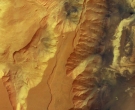Period of Long Eclipses Ending
After a request from the OMEGA instrument team, OMEGA operations were stopped on 7 February 2005, due to an interface temperature that is lower than expected. The proposed solution is to include an additional half an hour of heating before switch-on. Two tests will be performed next week with OMEGA. The main cause of this problem is likely to be that the eclipses are now moving closer to the pericenter.
The MELACOM Doppler link test with one of the Mars Exploration Rovers was successfully executed at the end of December 2004. No further use of the MELACOM communications package is foreseen at the moment.
Ground station configuration and maintenance at the DSS-14 (Goldstone) DSN ground station at the end of December 2004 implied that this station was only available in engineering-demo mode. Therefore, this has had a negative impact on payload operations (radio science) and science data downlink for a few days.
Science Planning Status
The planning for the Medium-Term Plans of March and April 2005 is being finalized. The planning of science operations for the April-May commanding periods is being performed, keeping the current MARSIS deployment date of 2 May in mind.
Science Highlights
The 15th Mars Express Science Working Team meeting and 27th Mars Express Science Operations Working Group meeting were held at ESTEC on 27 and 28 January 2005, respectively. The Principle Investigator (PI) teams summarized their main scientific results to date, and an overview of the upcoming Mars Express Science Conference, which will be held at ESA-ESTEC from 21 to 25 February 2005, was discussed.
Most PI teams have submitted major papers to American and European scientific journals. A summary of scientific results after one year of operations around Mars will be given by the PIs at the Mars Express Science Conference.
Since the December status report, the following images taken with the HRSC instrument have been released:



